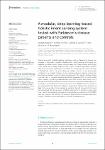A modular, deep learning-based holistic intent sensing system tested with Parkinson’s disease patients and controls
| dc.contributor.author | Russell, J | |
| dc.contributor.author | Inches, J | |
| dc.contributor.author | Carroll, CB | |
| dc.contributor.author | Bergmann, JHM | |
| dc.date.accessioned | 2023-12-18T10:56:30Z | |
| dc.date.available | 2023-12-18T10:56:30Z | |
| dc.date.issued | 2023-11-01 | |
| dc.identifier.issn | 1664-2295 | |
| dc.identifier.issn | 1664-2295 | |
| dc.identifier.other | ARTN 1260445 | |
| dc.identifier.uri | https://pearl.plymouth.ac.uk/handle/10026.1/21800 | |
| dc.description.abstract |
People living with mobility-limiting conditions such as Parkinson’s disease can struggle to physically complete intended tasks. Intent-sensing technology can measure and even predict these intended tasks, such that assistive technology could help a user to safely complete them. In prior research, algorithmic systems have been proposed, developed and tested for measuring user intent through a Probabilistic Sensor Network, allowing multiple sensors to be dynamically combined in a modular fashion. A time-segmented deep-learning system has also been presented to predict intent continuously. This study combines these principles, and so proposes, develops and tests a novel algorithm for multi-modal intent sensing, combining measurements from IMU sensors with those from a microphone and interpreting the outputs using time-segmented deep learning. It is tested on a new data set consisting of a mix of non-disabled control volunteers and participants with Parkinson’s disease, and used to classify three activities of daily living as quickly and accurately as possible. Results showed intent could be determined with an accuracy of 97.4% within 0.5 s of inception of the idea to act, which subsequently improved monotonically to a maximum of 99.9918% over the course of the activity. This evidence supports the conclusion that intent sensing is viable as a potential input for assistive medical devices. | |
| dc.format.extent | 1260445- | |
| dc.format.medium | Electronic-eCollection | |
| dc.language | eng | |
| dc.publisher | Frontiers Media SA | |
| dc.subject | Parkinson's disease | |
| dc.subject | wearable sensors | |
| dc.subject | intent sensing | |
| dc.subject | deep learning | |
| dc.subject | assistive medical devices | |
| dc.title | A modular, deep learning-based holistic intent sensing system tested with Parkinson’s disease patients and controls | |
| dc.type | journal-article | |
| dc.type | Article | |
| plymouth.author-url | https://www.ncbi.nlm.nih.gov/pubmed/38020624 | |
| plymouth.volume | 14 | |
| plymouth.publication-status | Published online | |
| plymouth.journal | Frontiers in Neurology | |
| dc.identifier.doi | 10.3389/fneur.2023.1260445 | |
| plymouth.organisational-group | |Plymouth | |
| plymouth.organisational-group | |Plymouth|Research Groups | |
| plymouth.organisational-group | |Plymouth|Faculty of Health | |
| plymouth.organisational-group | |Plymouth|Research Groups|Institute of Translational and Stratified Medicine (ITSMED) | |
| plymouth.organisational-group | |Plymouth|Research Groups|Institute of Translational and Stratified Medicine (ITSMED)|CCT&PS | |
| plymouth.organisational-group | |Plymouth|REF 2021 Researchers by UoA | |
| plymouth.organisational-group | |Plymouth|Users by role | |
| plymouth.organisational-group | |Plymouth|Users by role|Academics | |
| plymouth.organisational-group | |Plymouth|REF 2021 Researchers by UoA|UoA03 Allied Health Professions, Dentistry, Nursing and Pharmacy | |
| plymouth.organisational-group | |Plymouth|Faculty of Health|Peninsula Medical School | |
| plymouth.organisational-group | |Plymouth|Research Groups|FoH - Community and Primary Care | |
| plymouth.organisational-group | |Plymouth|Research Groups|FoH - Applied Parkinson's Research | |
| plymouth.organisational-group | |Plymouth|Research Groups|Plymouth Institute of Health and Care Research (PIHR) | |
| plymouth.organisational-group | |Plymouth|REF 2028 Researchers by UoA | |
| plymouth.organisational-group | |Plymouth|REF 2028 Researchers by UoA|UoA03 Allied Health Professions, Dentistry, Nursing and Pharmacy | |
| dc.publisher.place | Switzerland | |
| dcterms.dateAccepted | 2023-10-05 | |
| dc.date.updated | 2023-12-18T10:56:29Z | |
| dc.rights.embargodate | 2023-12-19 | |
| dc.identifier.eissn | 1664-2295 | |
| rioxxterms.versionofrecord | 10.3389/fneur.2023.1260445 |


